|
GoPro Hero3
GoPro strikes again with three new slimmed-down models that look the same, but are very different from one another
by Conrad Blickenstorfer
On October 17, 2012, GoPro announced the next generation of its world-beating little camera that's seemingly everywhere. Unlike the Hero2 that looked and felt virtually identical to the original Hero, the new Hero3 is smaller and lighter. And the Hero3 comes in three versions that may look the same, but are actually quite different. There's the White Edition (US$199), the Silver Edition (US$299), and the top-of-the-line Black Edition (US$399).
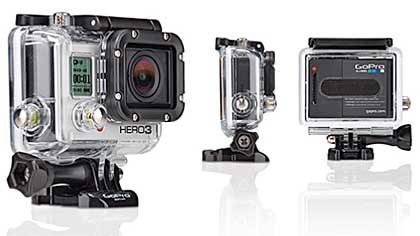
First, let's talk about the size. The GoPros were always tiny little boxes, but the Hero3 is smaller yet. Where the Hero2 weighed 3.5 ounces, the Hero3 has slimmed down to 2.6 ounces, and that's including battery and card. GoPro says the new model is also 30% smaller. No dimensions were given, but since the Hero3 is backward compatible with all the existing BacPacs, it must have the same footprint, and so we conclude that whereas the Hero2 was 37 mm thick (including the lens), the Hero3 is more like 26 mm, or about an inch. So the good news here is that the formerly very boxy little Hero now fits into small pockets much more easily, if that matters. The not so good news is that while all the old mounting gear works with the Hero3, the old wrist, skeleton and 3D housings won't. Below you can see the slimmer new package with its black plastic body and silver front fascia.
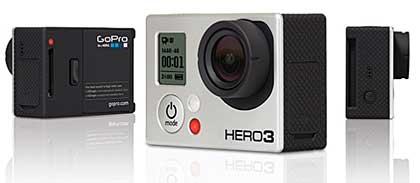
Now let's visit all the new stuff. First, all three of the new Heros have built-in WiFi. In the past, you needed to buy a WiFi BacPac and remote for US$99. Apart from the extra cost, that meant you couldn't use other BacPacs, like the LCD or extra battery. WiFi is now built in, but only the top-of-the-line Black Edition also comes with the WiFi remote. So if you need WiFi, the Black Edition is clearly the way to go since the remote alone costs US$79.99 (and there's plenty more that makes the Black model the best).
All three new models have what GoPro calls a new "ultra sharp F/2.8 6-element aspherical glass lens" for improved quality. 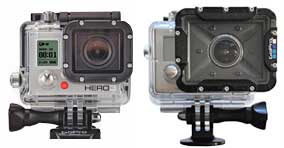 And all three come with a redesigned flat-lens housing with optics that let the cameras properly focus both above and under water. So for divers and snorkelers, there's no more need to buy a special dive housing. Excellent. What's more, the flat lens of the Hero3 housing doesn't cover half the status LCD as the old dive housing does. The picture above shows the new Hero3 on the left and a Hero2 in the optional dive housing on the right. And all three come with a redesigned flat-lens housing with optics that let the cameras properly focus both above and under water. So for divers and snorkelers, there's no more need to buy a special dive housing. Excellent. What's more, the flat lens of the Hero3 housing doesn't cover half the status LCD as the old dive housing does. The picture above shows the new Hero3 on the left and a Hero2 in the optional dive housing on the right.
Next, GoPro claims that a redesigned audio system better captures sound and its nuances, and also further reduces wind-noise and such. We hope to report on that when we have hands-on with the Hero3. And the whole line has switched from SD to microSD cards, up to 64GB. That's bad for folks who have invested in a good number of SD cards. 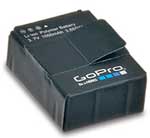 On the plus side, microSD is often cheaper than the regular cards. On the plus side, microSD is often cheaper than the regular cards.
Oh, and the battery in the new models (see picture to the right) is different, too, packing 1050mAH instead of 1100mAH. I had hoped for more instead of less as battery life has been one of our primary complaints in the past. The new battery's form factor means it is not interchangeable with older batteries.
Three very different models
While the three new Heros look identical, they aren't. In fact, the recording specs are so different that prospective users really need to wade through all of them before they decide which model works best for them. For example, the entry-level White Edition has rather basic video and still recording features that are closer to the level of the original Hero than even to the Hero2. The mid-level Silver Edition offers recording features close to the Hero2.
If you really want to ascend to the next level of GoPro videography though, it's the Black Edition that delivers all the goods. Thanks to an advanced 12-megapixel CMOS imager and Ambarella's A7 compression chip, the Black Edition can not only record 1080p HD video at a full 60 frames per second, but also records at what GoPro calls 2.7k (2716 x 1524 pixel) at 25 frames per second, and users can even start experimenting with the next big thing, 4k video. That's a full 3820 x 2160 pixel, or four times the size of 1080p's 1920 x 1080. For now, that only works at 15 frames per second, but since there really aren't any affordable 4k TVs or monitors yet, this mode is about getting acquainted with the future rather than mainstream production. Both of these super-high resolution modes come in two flavors, standard 16:9 and an even wider 17:9 "Cin" mode.
But that's not all. The Black Edition can also record at 100 fps in 960p, 120 fps in 720p, and 240 fps in 848 x 480 WVGA, making it eminently suitable for all sorts of slow motion projects. And the Black model can do stills and shoot video simultaneously, up to a still picture every five seconds in certain modes, using the sensor acquisition size of the selected video recording mode. What's more, the Black (and maybe Silver) Edition — and this is a first for GoPros — has selectable white balance settings. That can make a huge difference, and especially underwater.
Interestingly, even the photo modes of the three editions are different. The Silver and White Edition can do 5, 8 and 11mp stills like the Hero2, through the Silver Edition can shoot ten 11mp stills in burst mode whereas the White shoots at the same rate but only at 5mp. The Black Edition lets you select from 5, 7 or 12mp.
How can the three models be so different? One reason is that the Black Edition has the new Ambarella A7 chip whereas the other two use the same Ambarella A5s chip that was in the Hero2. They also have different imagers. I am not certain, but it seems that the White Edition uses a 5mp Aptina MT9P001, the Silver Edition the same Aptina MY9F002 as the Hero2, and the Black Edition a new 12mp sensor. So three very different sets of electronics, and only hands-on will tell how well each works.
Now let's take a quick look at the respective specs:
|
GoPro Hero3 Editions: Modes and Features
|
|
Model
|
Hero3 White
|
Hero3 Silver
|
Hero3 Black
|
|
4k/15fps
|
NA
|
NA
|
yes (UW)
|
|
4k Cin/12fps
|
NA
|
NA
|
yes (UW)
|
|
2.7k/25fps
|
NA
|
NA
|
yes (UW)
|
|
2.7k Cin/24fps
|
NA
|
NA
|
yes (UW)
|
|
1080p/60fps
|
NA
|
NA
|
yes (UW/M/N)
|
|
1080p/48fps
|
NA
|
NA
|
yes (UW/M/N)
|
|
1080p/30fps
|
yes (M)
|
yes (UW/M/N)
|
yes (UW/M/N)
|
|
1080p/24fps
|
NA
|
yes (UW/M/N)
|
yes (UW/M/N)
|
|
1440p/48fps
|
NA
|
NA
|
yes (UW)
|
|
1440p/30fps
|
NA
|
NA
|
yes (UW)
|
|
1440p/24fps
|
NA
|
NA
|
yes (UW)
|
|
960p/100fps
|
NA
|
NA
|
yes (UW)
|
|
960p/48fps
|
NA
|
NA
|
yes (UW)
|
|
960p/30fps
|
yes (UW)
|
yes (UW)
|
NA
|
|
720p/120fps
|
NA
|
NA
|
yes (UW/N)
|
|
720p/60fps
|
yes (UW)
|
yes (UW)
|
yes (UW/N)
|
|
720p/30fps
|
yes (UW)
|
yes (UW)
|
NA
|
|
WVGA/240fps
|
NA
|
NA
|
yes (UW)
|
|
WVGA/120fps
|
NA
|
yes (UW)
|
NA
|
|
WVGA/60fps
|
yes (UW)
|
NA
|
NA
|
|
Stills
|
5, 8, 11mp
|
5, 8, 11mp
|
5, 7, 12mp
|
|
Burst
|
5mp at 10 fps
|
up to 11mp at 10 fps
|
up to 12mp at 30 fps
|
|
Manual Burst
|
NA
|
NA
|
up to 10 fps
|
|
Stills + Video
|
NA
|
NA
|
yes
|
|
Engine
|
Ambarella A5S
|
Ambarella A5S
|
Ambarella A7
|
|
Engine core/speed
|
ARM11/528MHz
|
ARM11/528MHz
|
ARM11/528MHz
|
|
Imager (our guess)
|
5mp Aptina MT9P001
|
14mp Aptina MY9F002
|
12mp
|
|
WiFi
|
yes
|
yes
|
yes
|
|
WiFi Remote
|
no (optional)
|
no (optional)
|
yes
|
|
MSRP
|
US$199.99
|
US$299.99
|
US$399.99
|
Black Edition gets the Ambarella A7 chipset
As was the case with its predecessors, a good part of the Hero3's functionality is built around Ambarella video compression algorithms and system-on-chip technology. The original Hero used an Ambarella A2S chip and the Hero2 the Ambarella A5S, an SoC powered by a 528MHz ARM 11 processor. The White and Silver editions of the Hero3 still appear to use the Ambarella A5S, but the top-of-the-line Black edition uses the more advanced Ambarella A7.
That powerhouse of a chip still uses the same ARM 11 processor, but has 32-bit DDR3 memory instead of 16-bit DDR2, can process twice the Mpixels per second (500 vs 240), can capture video and stills at the same time, has much more powerful burst modes, and more. As a result, the Black Edition Hero3 can record at higher frame rates and at higher resolutions. For a tech briefing on the chip, see and its capabilities, see the Ambarella A7 brochure. In it, you can see that Ambarella stresses the 1080p/60 mode that the Black Edition has, and also what they call the 4Mp30 mode with 2560 x 1600 pixel.
The new flat-lens housing
As stated, the housing of the Hero3 is all new. The biggest difference is that it includes a flat lens similar to the optional dive lens housing required to take sharp pictures underwater. This used to be a big issue with the original GoPros. The company advertised the stock housing to be waterproof to 200 feet or so, but neglected to tell customers that all pictures and video underwater would be blurry as to be essentially unusable. ScubaDiverInfo.com pointed that out quite forcefully in our detailed reviews of the Hero and Hero2 after we had ended up with hours of blurry video of once-in-a-lifetime footage of giant Mantas in Socorro. GoPro can't totally be faulted for this egregious oversight as they started out, after all, in the surfing business (but even there, once the camera was underwater, video was blurry). The problem was serious enough to spawn a third party cottage industry offering various flatlens housings and modifications for the Hero and Hero2.
For an idea of how serious the underwater blur issue was, see the pics below. The old standard housing used on the left, a flat lens housing on the right.
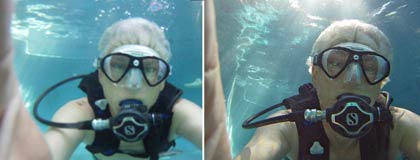
Why didn't GoPro get it right from the start? Because they designed the camera and lens to capture the GoPro signature ultrawide angle footage, but still wanted the enclosure to be as small and handy as possible. That meant the housing had a close-fitting curved lens over the camera's curved lens, with the result that the GoPro simply could not focus underwater. The fix seems simple as a flat lens in the housing cures the focus issue. But nothing is ever totally simple, and so due to the very wide shooting angles the GoPro uses, the flat lens had to be fairly large to preclude vignetting (darkish spots in the four corners). GoPro eventually came up with its own dive housing. It worked great, but covered up half of the already small status LCD.
Anyway, both issues are addressed with the Hero3. So thanks, GoPro, for fixing this once and forever. And if you have an old GoPro, do not go underwater without a flat lens housing!
What's Protune?
When you look at the specs of the new Hero3 models, you'll find that some video modes are available in Standard mode, some in Protune mode, and some in both. The White model doesn't have Protune at all (though it's available via firmware update for the Hero2), but the other two use it.
Protune was originally announced at NAB 2012 in Las Vegas, April of 2012 see press release). GoPro said that they were embedding TechniColor's CineStyle color profile (first designed for some Canon dSLRs) in the GoPro Protune firmware upgrade for the Hero2. CineStyle is a color profile designed to preserve colors and details especially in underexposed compressed video and also result in less noise. That means a better dynamic range, better highlight detail, and better shadow detail.
Technicolor, of course, has an illustrious history with its Technicolor motion picture process that pretty much ruled Hollywood film production between the early 1920s and early 1950s, and the company remained at the very forefront of film processing, video duplication and then digital video technologies and services.
ProTune is primarily meant to improve professional workflows and make the software more compatible with other professional products and sources. It adds the 24 fps frame rate used in big screen movies. There's also better quality compression by increasing the rate from 15 to 35Mbps, for a better image and virtual elimination of artifacts. Protune video can then be processed and tweaked in GoPro's CineForm Studio (basic version is free, see here) to convert the base flat look for best possible color, sharpness, contrast, etc. The latest version of CineForm Studio automatically detects when imported footage is Protune.
We don't know yet how Protune works on the Hero3, but we did upgrade the firmware in our two Hero2s. After the firmware update there is a Protune on/off menu choice. If Protune is on, the Hero2's video modes become 1080p in 30, 25 and 24 fps; 960p in 48 fps; and 720p in 60 fps. 960p and 720p in 30 fps and the WVGA modes go away. Side by side recording in standard and Protune modes yielded a rather flat Protune version, but once in CineForm, you can really make the footage pop.
Do note that when you use Protune, you better observe GoPro's storage card speed requirement. While our Class 4 cards always worked just fine in Hero2 standard mode, they did not work reliably in Protune mode.
For an explanation how Protune works, view this YouTube video from NAB 2012.
The GoPro Hero3
Unlike earlier GoPros, the new Hero3 comes in three flavors that look the same, but are actually very different. 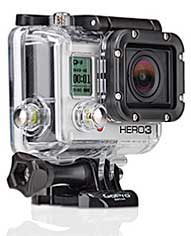 While all Hero3 models benefit from a lighter and slimmer body, a new flatlens housing that can focus underwater, integrated WiFi and a host of other improvements (buttons, audio, lens, low-light, etc.), there are substantial differences between the three editions. While all Hero3 models benefit from a lighter and slimmer body, a new flatlens housing that can focus underwater, integrated WiFi and a host of other improvements (buttons, audio, lens, low-light, etc.), there are substantial differences between the three editions.
In terms of recording features, the White (US$199) and Silver (US$299) Editions are like updated versions of the Hero and Hero2, whereas the Black Edition (US$399) is a genuine step forward with a new imager and more advanced compression technology that allows higher frame rates and higher resolution. This, the simultaneous still and video recording, and the inclusion of a WiFi remote make the Black Edition by far the most intriguing new model and probably the best deal.
We like:
- All Hero3s look the same, but there are distinctly different models for pros and casual users.
- New flatlens housing provides perfect focus above and under water, without the dome covering half the status LCD.
- Thinner profile, and even lighter.
- Lens appears much improved.
- Includes integrated WiFi.
- Lots of mounting gear and waterproof housing still included.
- Large on/off and mode button removes ambiguity.
- Can use existing BacPacs.
- Can use all existing mounting hardware.
- Black Edition has very useful new video and still modes.
- Black (and maybe Silver) Edition has white balance settings.
- Black Edition includes WiFi remote.
- Black Edition can shoots stills and video simultaneously.
Not so much:
- Why change size for no compelling reason?
- Battery remains undersized and not compatible with older batteries.
- Difficult to tell from specs which model is for who.
- New form factor won't fit into any older housings.
- Lack of white balance or scene settings requires filters underwater.
- Different compression chips and imagers may make line too complex.
- Still no image stabilization.
- Addition of Protune likely confusing to many users.
- At 15fps, 4k mode really only preview of coming attractions.
- Should come with standard charger in addition to USB charging.
- Still difficult to aim without LCD.
|
|
|
Specs GoPro Hero3 Black Edition
|
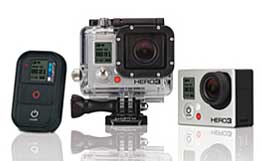
|
|
Status
|
Added 10/2012
|
|
Camera Type
|
Ultra-compact HD video camera
|
Body
|
Camera: plastic; Housing: acryllic
|
|
Water/dust protection
|
Housing: Max depth 200 feet
|
|
Operating temperature
|
unknown
|
|
Shock protection
|
unknown
|
Size
|
Camera: 2.4 x 1.6 x 1.0 inches (60 x 42 x 26 mm)
|
Weight (oz.)
|
Camera: 2.6 oz.; camera with housing: est. 6 oz.
|
CPU
|
Probably Ambarella A7 528MHz ARM11
|
Sensor Type
|
1/2.3" CMOS
|
Effective Pixels
|
12.0 mp |
File formats
|
Movie: MP4
Still: JPEG
|
Compression
|
Standard or Protune
|
Movie recording modes
|
15fps at 3820 x 2160 pixel
12fps at 4096 x 2160 pixel
25fps at 2716 x 1524 pixel
24fps at 2716 x 1440 pixel
48fps at 1920 x 1440 pixel
30fps at 1920 x 1440 pixel
24fps at 1920 x 1440 pixel
60fps at 1920 x 1080 pixel
48fps at 1920 x 1080 pixel
30fps at 1920 x 1080 pixel
24fps at 1920 x 1080 pixel
100fps at 1280 x 960 pixel
48fps at 1280 x 960 pixel
30fps at 1280 x 960 pixel
120fps at 1280 x 720 pixel
60fps at 1280 x 720 pixel
30fps at 1280 x 720 pixel
240fps at 848 x 480 pixel
|
Movie FOV
|
170° "wide" (all)
127° "medium" (1080p only)
90° "narrow" (1080p only)
|
Max movie pixels
|
4096 x 2160 (4k Cin wide)
|
Voice recording
|
Video records AAC mono sound with automatic gain control
|
Shutter Speed
|
NA
|
Image stabilization
|
NA
|
Lens type
|
Glass, 6 elements
|
Lens angle
|
2.7k/4k: 170 degrees
1080p: 90, 127, 170 degrees
720p: 9-, 170 degrees
Others: 170 degrees
|
Focal length
|
unknown
|
Aperture
|
f/2.8
|
Zoom (optical/digital)
|
none
|
Focus modes
|
Fixed
|
Lens focus
|
unknown
|
Sensitivity (ISO)
|
unknown
|
Autofocus system
|
NA (fixed)
|
Metering
|
center or spot
|
White-balance modes
|
Auto, 3000k, 5500k, 6500k, Raw
|
Shooting modes
|
Photo, burst, continuous photo, video, time-lapse, self timer
|
Exposure compensation
|
NA
|
Viewfinder Type
|
none (optional snap-on 2" BacPac LCD available)
|
LCD size
|
none (optional snap-on 2" BacPac LCD available)
|
LCD type
|
NA
|
LCD construction
|
optional snap-on
|
Camera internal memory
|
none
|
Storage Medium
|
micro-SDHC (up to 64GB)
|
I/O
|
mini-USB, mini-HDMI, 3.5mm mic, GoPro expansion
|
Battery type
|
3.7V 1,050mAH Li-Ion
|
CIPA Battery life
|
unknown
|
WiFi
|
integrated, includes WiFi remote
|
List Price
|
US$399.99 (camera, housing, WiFi remote, basic mounts)
|
Contact
|
Hero3 Black Edition website
|
Overall Verdict
|
The top-of-the-line "black" Hero3 is for those who need maximum performance and flexibility in video modes and formats. Its internal technology is the most advanced by far, it includes the WiFi remote that costs extra in the other two editions, and it allows exploring upcoming video format beyond current HD.
|
|
|
Specs GoPro Hero3 Silver Edition
|
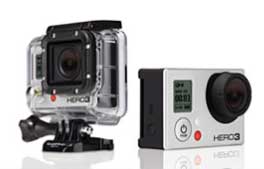
|
|
Status
|
Added 10/2012
|
|
Camera Type
|
Ultra-compact HD video camera
|
Body
|
Camera: plastic; Housing: acryllic
|
|
Water/dust protection
|
Housing: Max depth 200 feet
|
|
Operating temperature
|
unknown
|
|
Shock protection
|
unknown
|
Size
|
Camera: 2.4 x 1.6 x 1.0 inches (60 x 42 x 26 mm)
|
Weight (oz.)
|
Camera: 2.6 oz.; camera with housing: est. 6 oz.
|
CPU
|
Ambarella A5S 528MHz ARM11
|
Sensor Type
|
1/2.3" CMOS probably Aptina MY9F002
|
Effective Pixels
|
14.0 mp |
File formats
|
Movie: MP4
Still: JPEG
|
Compression
|
Standard or Protune
|
Movie recording modes
|
30fps at 1920 x 1080 pixel
24fps at 1920 x 1080 pixel
100fps at 1280 x 960 pixel
30fps at 1280 x 960 pixel
60fps at 1280 x 720 pixel
30fps at 1280 x 720 pixel
120fps at 848 x 480 pixel
|
Movie FOV
|
170° "wide" (all)
127° "medium" (1080p only)
90° "narrow" (1080p only)
|
Max movie pixels
|
1920 x 1080 (1080p)
|
Voice recording
|
Video records AAC mono sound with automatic gain control
|
Shutter Speed
|
NA
|
Image stabilization
|
NA
|
Lens type
|
Glass, 6 elements
|
Lens angle
|
1080p: 90, 127, 170 degrees
Others: 170 degrees
|
Focal length
|
unknown
|
Aperture
|
f/2.8
|
Zoom (optical/digital)
|
none
|
Focus modes
|
Fixed
|
Lens focus
|
unknown
|
Sensitivity (ISO)
|
unknown
|
Autofocus system
|
NA (fixed)
|
Metering
|
center or spot
|
White-balance modes
|
Auto
|
Shooting modes
|
Photo, burst mode, video, time-lapse, self timer
|
Exposure compensation
|
NA
|
Viewfinder Type
|
none (optional snap-on 2" BacPac LCD available)
|
LCD size
|
none (optional snap-on 2" BacPac LCD available)
|
LCD type
|
NA
|
LCD construction
|
optional snap-on
|
Camera internal memory
|
none
|
Storage Medium
|
micro-SDHC (up to 64GB)
|
I/O
|
mini-USB, mini-HDMI, 3.5mm mic, GoPro expansion
|
Battery type
|
3.7V 1,050mAH Li-Ion
|
CIPA Battery life
|
unknown
|
WiFi
|
integrated, does not include WiFi remote
|
List Price
|
US$299.99 (camera, housing, WiFi remote, basic mounts)
|
Contact
|
Hero3 Silver Edition website
|
Overall Verdict
|
The middle-of-the-line "silver" Hero3 combines the performance and video/still modes of the Hero2 in the new, sleeker package and adds general updates like the new lens, internal WiFi (but the remote costs extra), and better audio. And you can even use Protune in some modes.
|
|
|
Specs GoPro Hero3 White Edition
|

|
|
Status
|
Added 10/2012
|
|
Camera Type
|
Ultra-compact HD video camera
|
Body
|
Camera: plastic; Housing: acryllic
|
|
Water/dust protection
|
Housing: Max depth 200 feet
|
|
Operating temperature
|
unknown
|
|
Shock protection
|
unknown
|
Size
|
Camera: 2.4 x 1.6 x 1.0 inches (60 x 42 x 26 mm)
|
Weight (oz.)
|
Camera: 2.6 oz.; camera with housing: est. 6 oz.
|
CPU
|
Ambarella A7 528MHz ARM11
|
Sensor Type
|
1/2.3" CMOS probably Aptina MY9P001
|
Effective Pixels
|
5.0 mp |
File formats
|
Movie: MP4
Still: JPEG
|
Compression
|
Standard only
|
Movie recording modes
|
30fps at 1920 x 1080 pixel
30fps at 1280 x 960 pixel
60fps at 1280 x 720 pixel
30fps at 1280 x 720 pixel
60fps at 848 x 480 pixel
|
Movie FOV
|
170° "wide" (960p, 720p, WVGA)
127° "medium" (1080p only)
|
Max movie pixels
|
1920 x 1080 (1080p)
|
Voice recording
|
Video records AAC mono sound with automatic gain control
|
Shutter Speed
|
NA
|
Image stabilization
|
NA
|
Lens type
|
Glass, 6 elements
|
Lens angle
|
1080p: 127 degrees
Others: 170 degrees
|
Focal length
|
unknown
|
Aperture
|
f/2.8
|
Zoom (optical/digital)
|
none
|
Focus modes
|
Fixed
|
Lens focus
|
unknown
|
Sensitivity (ISO)
|
unknown
|
Autofocus system
|
NA (fixed)
|
Metering
|
center or spot
|
White-balance modes
|
Auto
|
Shooting modes
|
Photo, burst mode, video, time-lapse, self timer
|
Exposure compensation
|
NA
|
Viewfinder Type
|
none (optional snap-on 2" BacPac LCD available)
|
LCD size
|
none (optional snap-on 2" BacPac LCD available)
|
LCD type
|
NA
|
LCD construction
|
optional snap-on
|
Camera internal memory
|
none
|
Storage Medium
|
micro-SDHC (up to 64GB)
|
I/O
|
mini-USB, mini-HDMI, 3.5mm mic, GoPro expansion
|
Battery type
|
3.7V 1,050mAH Li-Ion
|
CIPA Battery life
|
unknown
|
WiFi
|
integrated, does not include WiFi remote
|
List Price
|
US$199.99 (camera, housing, WiFi remote, basic mounts)
|
Contact
|
Hero3 White Edition website
|
Overall Verdict
|
The entry level "white" Hero3 takes over in terms of performance and video/still modes for the no longer offered original Hero, but in the new, sleeker package and with general updates like the new lens, internal WiFi (but the remote costs extra), and better audio. The White Edition doesn't have the Protune mode, but unless you're a pro, you won't miss it. This is the one for casual users who never saw a reason to pick the Hero2 over the original Hero.
|
|
|
|
|










